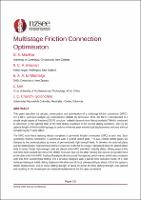| dc.contributor.author | MacRae, Gregory | |
| dc.contributor.author | Brosnan, Ruaidhri | |
| dc.contributor.author | El-Mashalgi, Bader | |
| dc.contributor.author | Luo, Zheng | |
| dc.contributor.author | Chanchí Golondrino, Jose | |
| dc.contributor.author | Coral Potosí, Hugo Anderson | |
| dc.date.accessioned | 2024-07-01T02:01:21Z | |
| dc.date.available | 2024-07-01T02:01:21Z | |
| dc.date.issued | 2024-04-09 | |
| dc.identifier.uri | https://repo.nzsee.org.nz/xmlui/handle/nzsee/2753 | |
| dc.description.abstract | This paper describes the use of multi-stage friction connections (MFCs) to modify hysteresis curve characteristics of structures in order to decrease their peak and residual displacements. Both cases with and without P-delta analysis are considered.
It is shown that a two-stage MFC configuration may economically fabricated for friction connections with different numbers of bolts at each end of the connection, and providing different sliding lengths at the weaker end of the connection. (This is the end with fewer bolts.) The performance of the MFC is demonstrated experimentally.
A numerical study is then conducted using OpenSEES confirming the single degree of freedom model behaviour through push/pull analysis considering an elastoplastic single degree of freedom model with no P-delta, and one including P-delta effects resulting in a small negative post-yield stiffness ratio of -0.03.
The model's dynamic performance was assessed via time history analysis (THA) using 22 pairs of scaled earthquake records for SDOF models with a period of 1.0 s and a lateral force reduction factor of 4.0 to determine optimal strength and gap ratios of the MFC. It was found that the optimal MFC configuration included a first-stage gap length of 0.4 times the system's elastic displacement, and a first stage sliding strength of 0.5 times the system's reduced elastic force. This reduced the peak and residual displacements by 30% for peak values and 75%, respectively compared to the EPP model with no P-delta, and 40% and 220%, respectively compared to the model with P-delta. | |
| dc.language.iso | en | |
| dc.publisher | New Zealand Society for Earthquake Engineering | |
| dc.relation.ispartofseries | 2024;78 | |
| dc.subject | Seismic performance, risk mitigation and resilience of new and existing structures | |
| dc.title | Multistage Friction Connection Optimisation | |
| dc.type | Article | |

